Tangential Honey Extractor: What is it? A Beginners Guide
As a new beekeeper deciding which honey extractor to buy can be a difficult decision. Beginner beekeepers often start by purchasing a tangential honey extractor, but what exactly is this type of extractor and how does it work?
The tangential honey extractor harvests one side of the honey frame at a time and requires manual flipping of the frames. It is limited to 2 to 8 frame models, available in manual and electric, is a thorough but inefficient honey extractor, and the most inexpensive extractor for beginners.
Investing in a honey extractor will likely be your most expensive investment other than the initial setup of your hives. In this guide I’ll explain what a tangential extractor is, the best methods of use, choosing the correct size, how much they cost, and where to buy one.
What Is A Tangential Honey Extractor
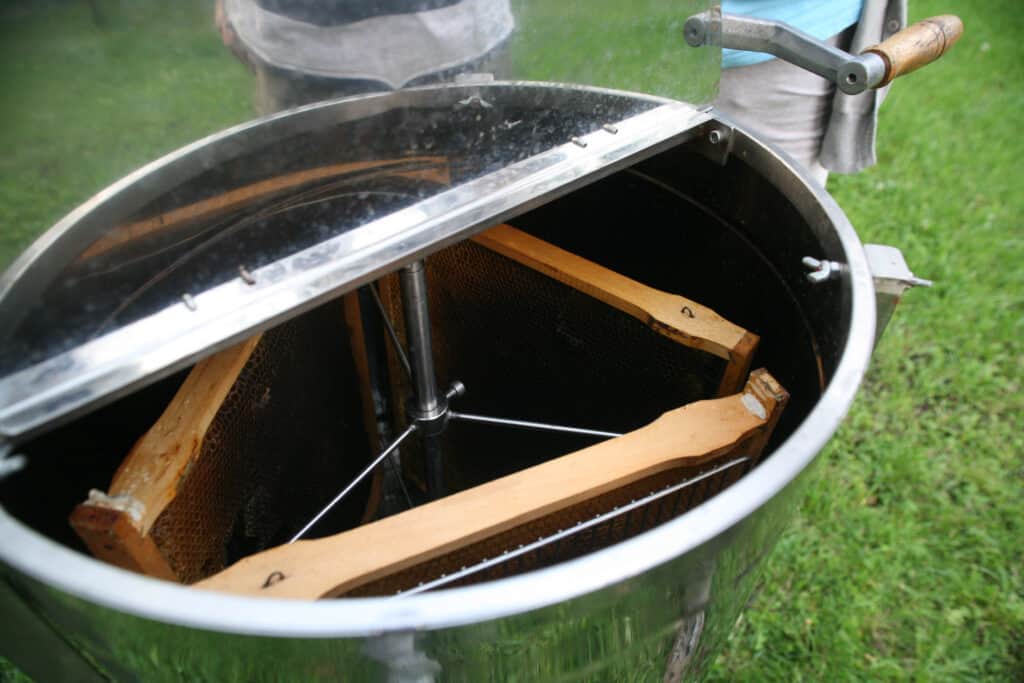
Tangential honey extractors use centrifugal force by spinning the basket containing honey frames and slinging the honey to the sides of the drum or barrel. The honey then flows down to the bottom where there is a valve (honey gate) for the honey to be drained. They can be spun manually with a hand crank or automatically with an electric motor.
These extractors can only extract honey from one side at a time, so you do have to flip the frames multiple times to extract all of the honey. I like tangential extractors because they do extract honey more thoroughly even if they are not as efficient as radial extractors. But once you get some practice you can extract your honey pretty quick.
Also, tangential extractors can be very forgiving for speed control. The comb is nearly always fully emptied with the wood frames being close to dry. But you do need good grills in the basket to prevent foundation blow outs if you use to much speed on a full frame.
Pro Tip: Ensure you have a high quality honey gate that is easy to open with a good seal. You will avoid leaking your precious honey all over the floor and endless frustration.
As I stated above, you can purchase tangential extractors in both manual or electric models but they do have a pretty limited frame capacity. The sizes range from 2 to 8 frame models. Most 2 and 4 frame models can handle all frame sizes: deeps, mediums, and shallows. But once you get into the 6 and 8 frame models they usually can’t handle more than 4 deep frames at a time.
The model and size of the honey extractor you choose is very dependent on the size of your honey supers. If you’re running deep or medium supers you will have more limited options for tangential extractor capacity compared to using shallow honey supers. This makes sense considering how much more heavy a deep honey super is compared to a shallow one.
That being said, the frame size simply limits how quickly you can extract your honey. But I’ll explain a good method on how to best load and run your tangential extractor to ensure a thorough and efficient harvest.
Extracting Honey Using A Tangential Extractor
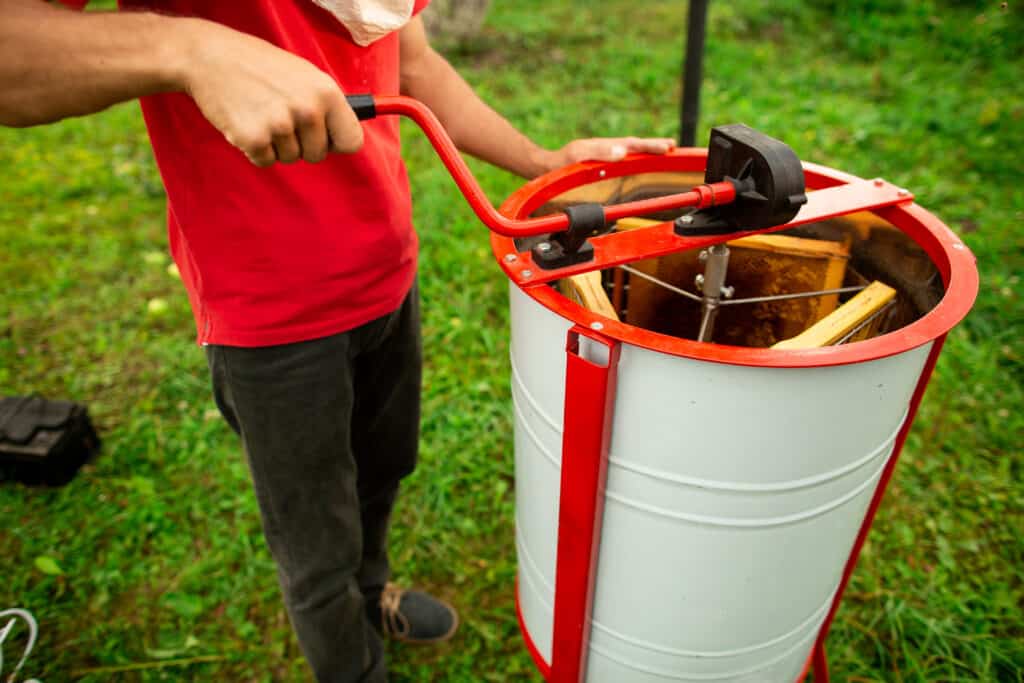
Harvesting honey is a lot of work so I’m going to ensure you don’t have a miserable and tedious ordeal while extracting your honey. Also don’t push and rush this process otherwise you will get very frustrated and have nothing but issues.
I recommend you check the operation manual for your extractor to confirm that this method will work. But for most part this a pretty standard way of extracting your honey with a tangential extractor.
Loading and Extraction Steps:
- If possible only extract warm comb.
- Load your frames following the capacity of your extractor.
- Only load equally honey laden frames across from each other and never try to extract an odd number against the basket.
- Start slow and only partially extract the first side.
- Flip the frames and only partially extract that other side.
- Flip the frames again, now you can extract the rest of that side at a much higher speed.
- Flip the frames one last time and extract the rest of the frame.
As I mentioned above these extractors are very forgiving for speed control and with sturdy frame baskets you won’t have to worry about foundation blow outs.
The process is faster with an electric tangential extractor, since you’re not hand cranking. With practice you can extract the frames in 3-4 minutes even with flipping and slowly ramping up your speed.
In some cases you can extract your honey faster than a radial extractor which can take upwards of 8-9 minutes to perform the same extraction.
Here is a video extracting honey using a 3 frame tangential extractor. It’s not exactly the method I use but its pretty close and a good demonstration.
What Size Tangential Extractor Should I Choose
A popular saying among beekeepers is “buy as big as your budget will allow”. Experienced beekeepers often state that if they could start over they would have just saved they’re money and bought a much larger extractor.
Now this isn’t necessarily realistic for all beginner beekeepers. A large number are not interested in having more than 5 or 6 colonies and won’t be harvesting a ton of honey every year.
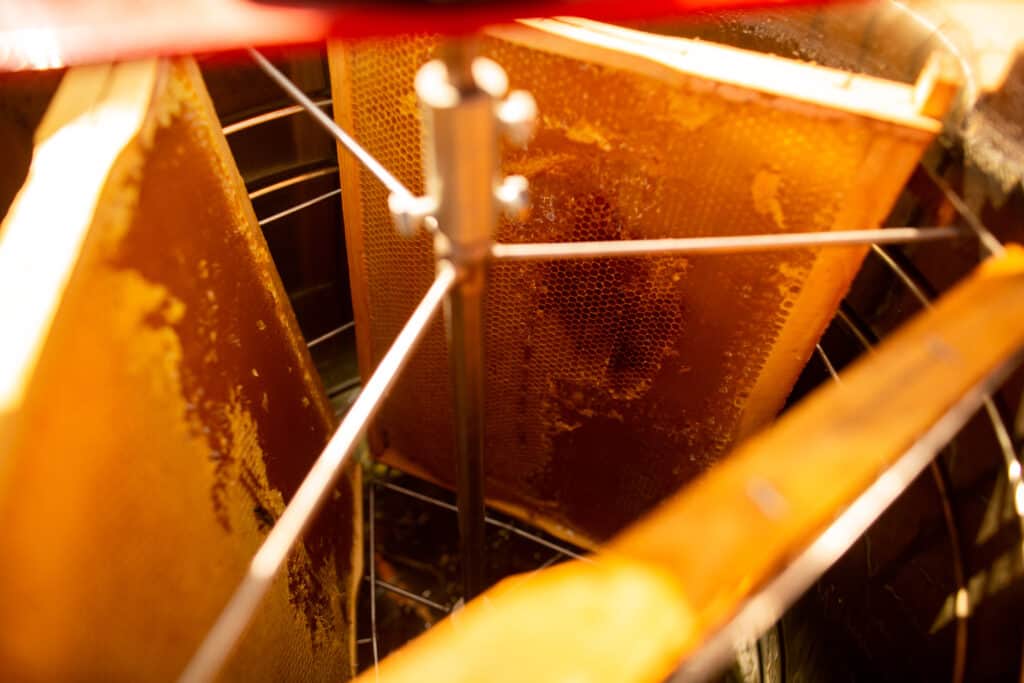
But to help both the hobbyist, and the beginner beekeeper who does want to continue to expand their apiary, I’ll provide you with some general guidelines and a chart for reference.
A manual hand crank 2 frame extractor will work well if you have 1 to 4 colonies and don’t plan on expanding your apiary. If you plan on having 4 to 6 colonies, even upwards of 10 colonies, I would recommend going with a 3 or 4 frame manual extractor.
Now if you’re planning on expanding and will have between 6 to 40 colonies then a 4 frame electric tangential extractor will work well for you. But once you get past 40 colonies I would recommend buying a radial extractor.
| Extractor Size | Number of Hives | Manual Or Electric |
| 2 Frame | 1 to 4 hives | Manual Extraction |
| 3 or 4 Frame | 4 to 6 hives | Manual Extraction |
| 4 Frame | 6 to 40 hives | Electric Extraction |
You can also get some pretty decent deals from other local beekeepers and buy a used honey extractor. Or you can continue to save your money and pay another beekeeper to extract your honey or even rent one. That way you can save your money for the one extractor you do want to buy that will last you for many years.
In many regions you can rent honey extractors for pretty reasonable prices. In my region in Ontario there are several beekeepers that will rent out extractors for you to use. This is also a service that you could potentially offer later down your beekeeping journey.
How Much Do Tangential Extractors Cost

There is a pretty wide range of tangential honey extractors on the market and they are definitely not created equally. They can range in price from a 2 frame manual extractor for $237.50 to a 6/3 frame electric extractor for $1049.95. Some extractors even offer both tangential and radial modes.
I would keep in mind the availability of replacement parts and upgrade kits before necessarily ordering the lowest cost extractor available online. Some extractors have the option of upgrading your extractor by simply adding a motor and even expanding the number of frames from 4 to 6 that you can extract.
What you decide to purchase will inevitably depend on how many hives you have and/or plan to expand too in the future, the amount of space to house your extractor, and your financial resources.
I’ve spent a long time researching different honey extractors and there is only a few brands that I would recommend. These different extractors have proper customer support and warranties, available replacement parts, high quality control, and in some cases upgradeable options. These brands are well known within pretty much all beekeeper circles and have been well tested.
Also, I’m not making any money off of these recommendations. I simply want to provide the information so you can make an informed choice, especially given how expensive honey extractors can be. In the future I’m hoping to be able to offer some of these models for sale, but for now I don’t sell honey extractors.
Here is the breakdown by brand (Mann Lake, Dadant, Lyson, and Dancing Bee), price, and features with a link to the companies product page. All prices are listed in US dollars unless otherwise stated.
Mann Lake Tangential Honey Extractors
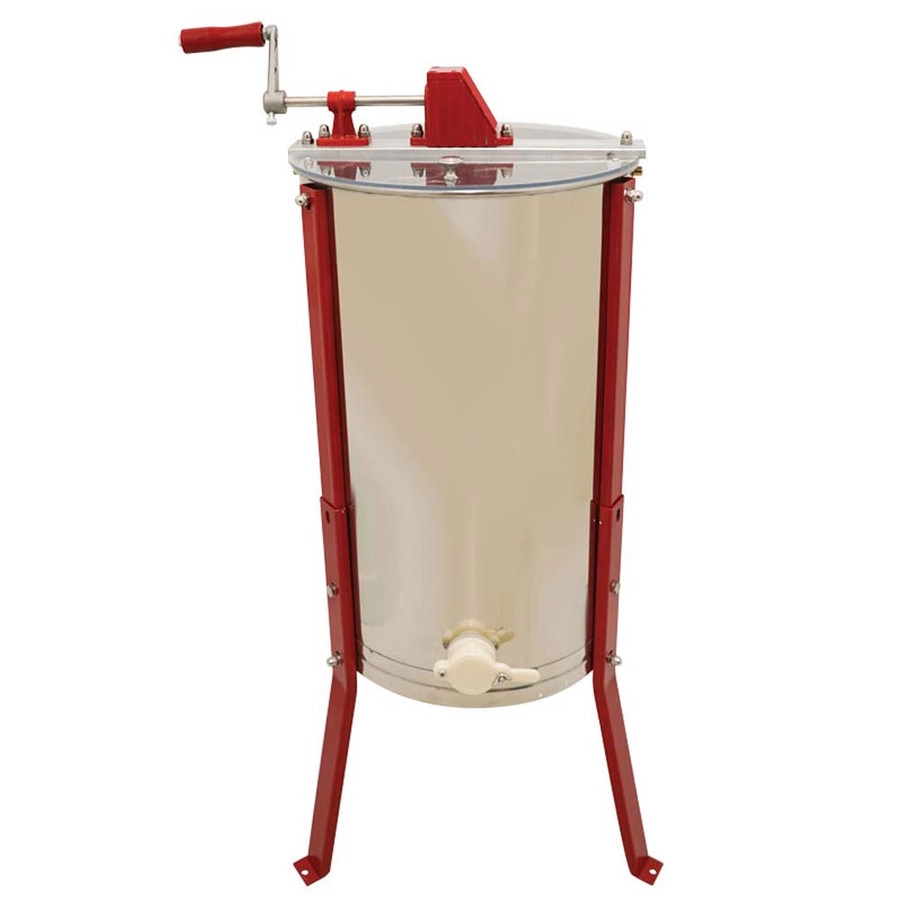
Mann Lake has three tangential honey extractors, two manual and one electric.
- 3 Frame Stainless Steel Side Hand Crank Extractor – It can extract 3 standard deep, medium or shallow frames and includes stainless steel legs and the honey gate valve. Made with stainless steel. Measurement: 33.46″ x 14.96″ x 14.96″ Weight: 28.60 lbs Current Price: $344.95 with free shipping in the United States This is a pretty decent price for a basic 3 frame manual honey extractor from a company that has been manufacturing beekeeping equipment for many years.
- 6/3 Side Hand Crank Frame Extractor – It can extract 3 standard deep, 3 medium, or 6 shallow honey frames. This one also includes legs and the honey gate. Made with 26 gauge stainless steel. Measurement: 20″ x 40″ x 23″ Weight: 49.1 lbs. Current Price: $624.95 with free shipping in the United States
- 6/3 Motorized Frame Extractor – All the same features as above except this one has a motor. Current Price: $1049.95 with free shipping in the United States
Dadant Tangential Honey Extractors

Dadant has three tangential honey extractors, 2 manual and 1 electric.
- 2-Frame Hand Extractor – It can extract 2 standard deep, medium or shallow frames. It includes removeable legs and a plastic honey gate. Its made of 24 gauge stainless steel and can be converted into a 175 lb honey storage tank. Measurements: 14″ x 23 1/4″ Weight: 27 lbs. Current Price: $497.95 with free shipping in the United States
- 4-Frame Hand Extractor – It can extract 4 standard deep, medium or shallow frames. It includes removeable legs and a the honey gate valve. Its made of 24 gauge stainless steel and can be converted into a 300 lb honey storage tank. Can be converted to a 6 frame manual radial extractor, or a 6 frame radial power extractor. Measurements: 18″ x 40″, and 16″ to bottom of honey gate Weight: 78 lbs. Current Price: $599.95
- 4-Frame Power Extractor – All the same features as above except this one has a motor. This one can also be converted into a 6 frame radial power extractor. Current Price: $970.95
Lyson Tangential Honey Extractors

Lyson has four tangential honey extractors, 2 manual and 2 electric.
- 4 Frame Manual Extractor – It can extract 2 standard deep frames, 4 medium or shallow frames. It includes steel legs and 1 1/4″ stainless steel honey gate valve. Measurements: 16″ x 29″ Current Price: $345.95
- 8 Frame Compact Manual Extractor – It can extract 4 standard deep and medium frames or 8 shallow frames. It includes steel legs and stainless steel honey gate valve. It can be upgraded to a powered extractor by adding the Lyson motor kit. Measurements: 20″ x 37 1/4″ Weight: 40 lbs Current Price: $439.95
- 8 Frame Compact Motorized Extractor – All the same features as above except this one has a motor Current Price: $595.50
- 8 Frame Optima Motorized Extractor – It can extract 4 standard deep and medium frames or 8 shallow frames. It includes 250 watt motor, steel legs and stainless steel honey gate valve. It can be upgraded to a powered extractor by adding the Lyson motor kit. Current Price: $879.95
Dancing Bee Tangential Honey Extractors
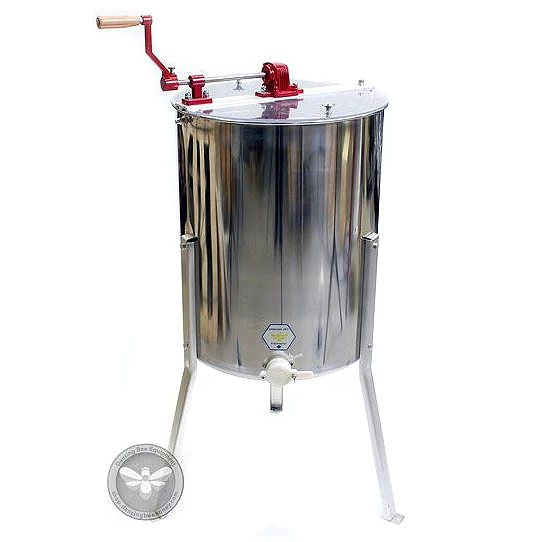
Dancing Bee has two manual tangential honey extractors.
- Honey Max 2 Frame Manual Extractor – It can extract 2 standard deep, medium or shallow frames. It includes steel legs and a plastic honey gate valve. Current Price: $237.50 + Shipping
- Honey Max 4 Frame Manual Extractor – It can extract 4 standard deep, medium or shallow frames. It includes steel legs and a plastic honey gate valve. Current Price: $332.50 + Shipping
I do like the Honey Max line of manual extractors since their price is quite affordable and have they been around for many years both in Canada and the United States.
As I mentioned earlier keep an eye out for good used equipment in your local region. Beekeepers often sell their old equipment and you may be able to get a good deal.
Whether you purchase a brand new extractor or find a good used one, my goal is to help you make an informed decision on a very important piece of equipment in your apiary.
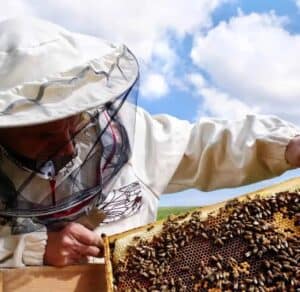
Joseph Davis
My goal is to show that anyone can take up beekeeping and it can be a very rewarding hobby. I strive to share my experiences and answer any questions you may have.
